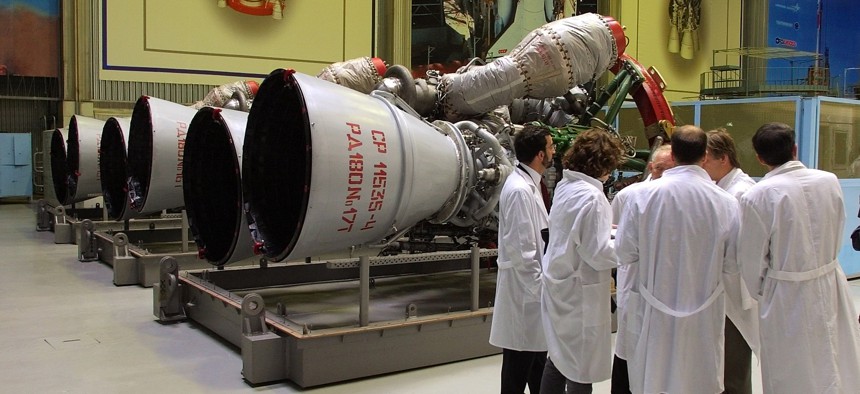
Energomash company employees stand near RD-180 engines prepared for shipment to the United States in a shop at the Energomash, leading Russian rocket engine company, in Moscow, June 6, 2002. Maxim Marmur/AP
Wishing for a US-Made Heavy Lift Rocket Won’t Make It So
If Congress really wants to ditch Russia’s RD-180 engine, it needs to fund the research — and get ready to wait.
No one needs to review rocket blueprints, wins and losses, or successful and failed launches, to know that the business of getting heavy lift payloads into space is a tricky one. It took a decade and several step changes in engine technology (Atlas, Atlas IIAS, Atlas III, and finally Atlas V) to develop what we use today, a proven American rocket with a proven Russian rocket engine. It will take at least another decade, according to recent expert assessments, to get an American-made heavy lift rocket engine designed, tested, and regularly into space without mishap.
So why is Congress still kicking a dead horse—or a dead rocket idea?
These days, we hear more about rocket misfires, engine troubles, bungled landings, and failures dressed as success than we do about plain vanilla launches of long-tested rockets that accomplish the mission. Even as young rocket companies repeatedly push the public relations button, arguing that every new launch they undertake is somehow a step closer to heavy lift or a trip to Mars, actual heavy lift missions draw only yawns. Particularly uneventful are launches of Atlas Vs that put critical cargo into deep orbit with the Russian RD-180 engine that Congress so dislikes.
Then there’s the other half of the Russian-American space relationship: Russia’s agreement to transport American astronauts to and from the International Space Station.
Unless we aim to give up both kinds of missions for the time being, we are best not to give up either. We still want Americans in space, even as we wait for a reliable American-built engine to get our astronauts there. And we still want a heavy lift capacity to preserve U.S. national security.
Related: This Painfully Honest Look at the Space Industry Just Got an Executive Fired
See also: How 3D Printing Could Help Replace Russian Rockets
So what is the big deal? As some in Congress have pointed out, America trades by the billions of dollars with Russia each year—as we do with China—and we are also cooperative in many spheres, especially space. So then, why all this squawking, in the U.S. Senate especially, about working with Russia to get our astronauts and key payloads safely into space?
In sum, one or two U.S. Senators apparently want to grease the skids of heavy lift space launch for a smaller American space company to take over the job.
In principle, one has to say: Why not? If we had the existing engine, and could do it, why not switch to American heavy lift engines? Unfortunately, that option is roughly a decade away, and members of Congress know it. The Wall Street Journal reported last month that even leading experts, part of an “independent panel,” concluded that Congress should stand down—or at least not attempt to push heavy lift capacity toward an ill-prepared American company. Such a move would, they reported, be technically unwise, inordinately expensive, and “risky” for national security.
This may be sobering news, but it is also not unexpected. Congress has dawdled for years both over human (i.e., man-rated) space launch options and, more obviously, by doing nothing in the area of fostering reliable heavy lift launch capacity with an American-made rocket engine.
So, we are where we are. Congress should obviously underwrite a decade of research, design, development, testing and whatever else is needed, to get an American engine that has real heavy lift capability. They should also stop feuding among themselves, and recognize that we have an option today—as politically imperfect a solution as it may be.
The option we have today is a live horse, a live rocket, a live option. Moreover, this space launch work horse—the combination of Atlas V and RD-180 engines—continues to accomplish its missions reliably and safely.
Congress should get back to what matters—like long-term planning and balanced budgets—instead of parochial square-offs, cranky hearings and personal tiffs. Let’s use in space—as we do here on Earth—what works, while planning for a decade out. Let us get past the costly, emotional, politically-motivated idea that heavy lift engines made in America are close at hand.
Kicking these dead horses—and rockets—is getting old fast.
NEXT STORY: Obama Drops Rhetoric as Assad Drops Barrel Bombs



